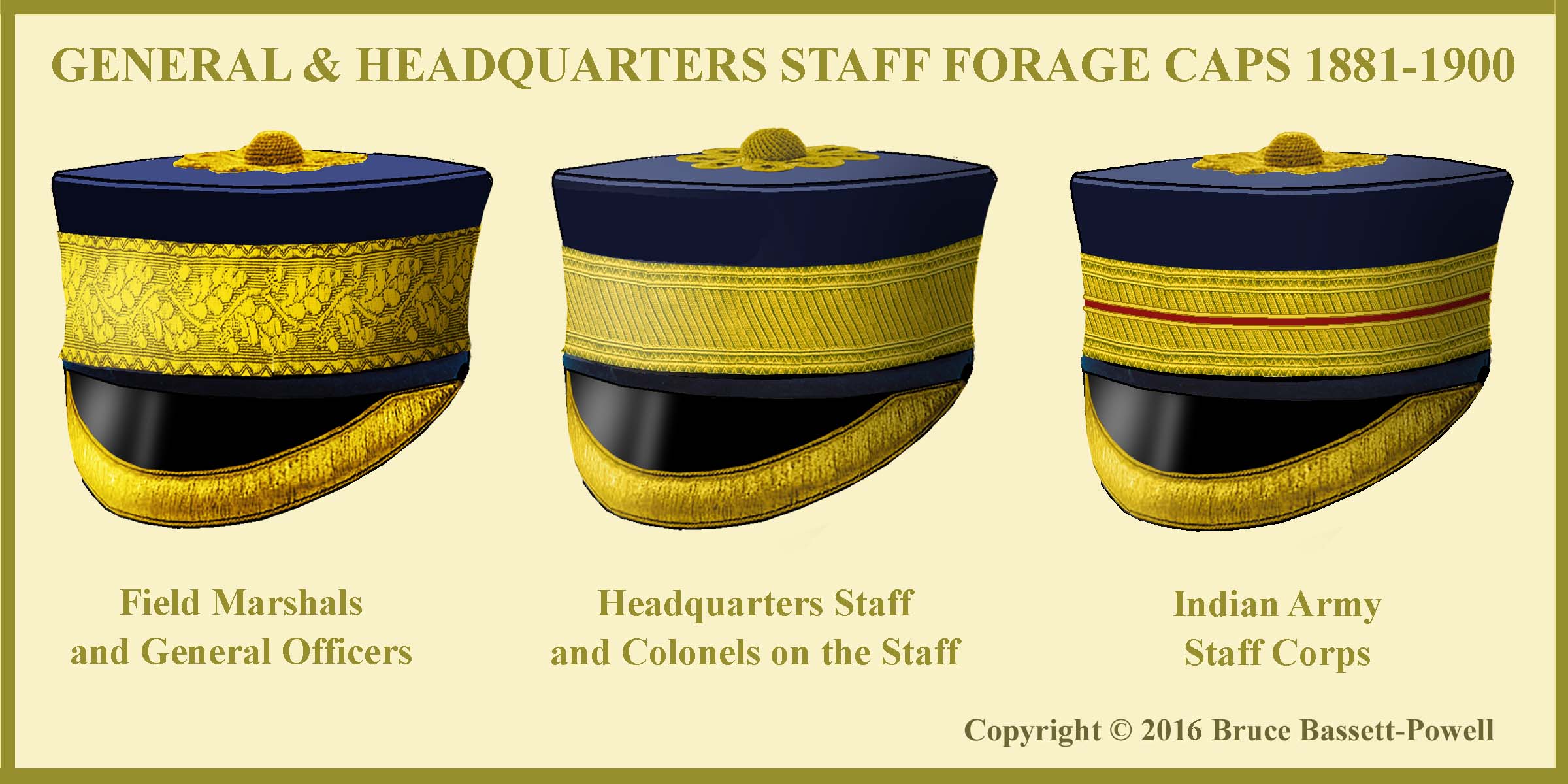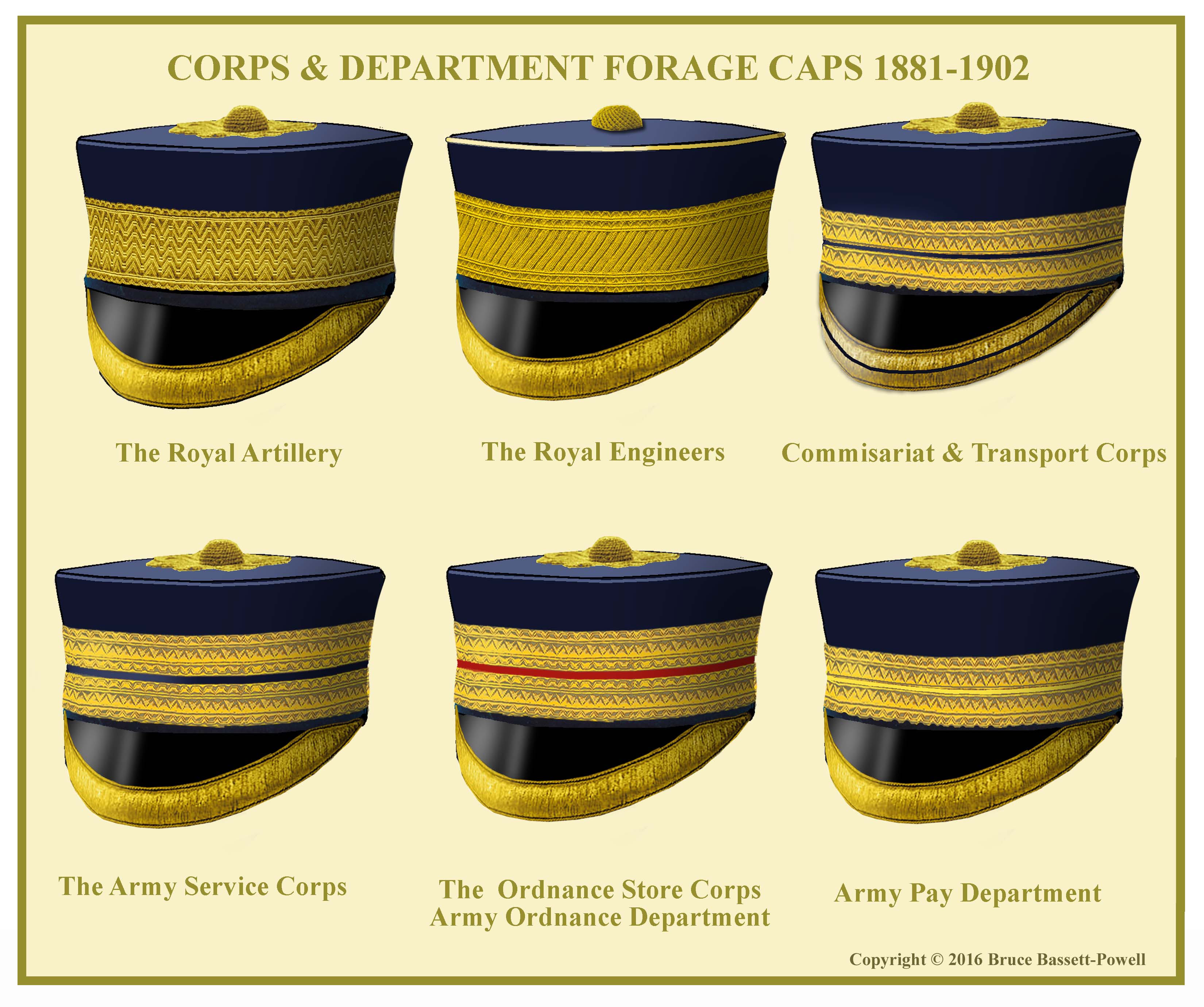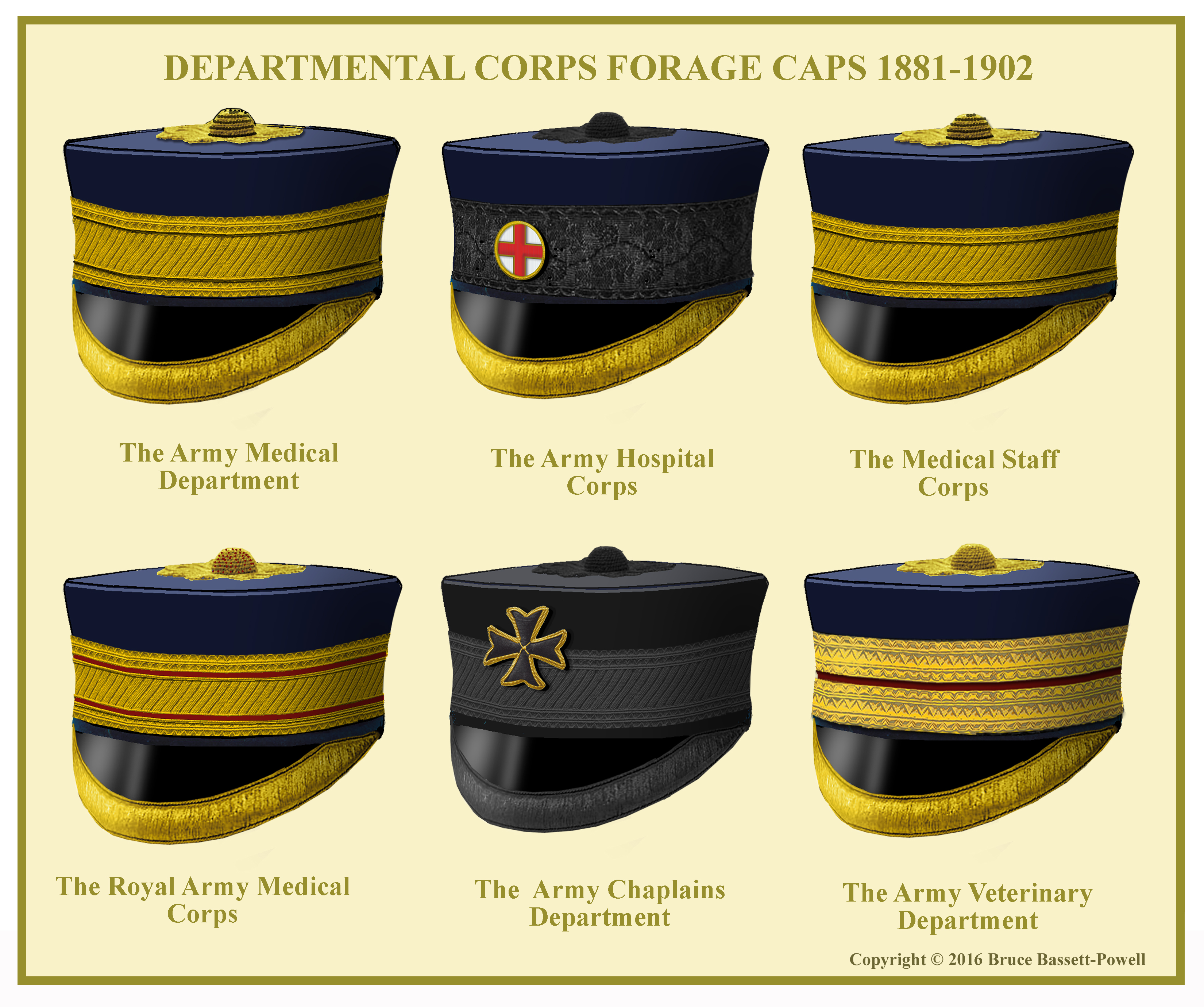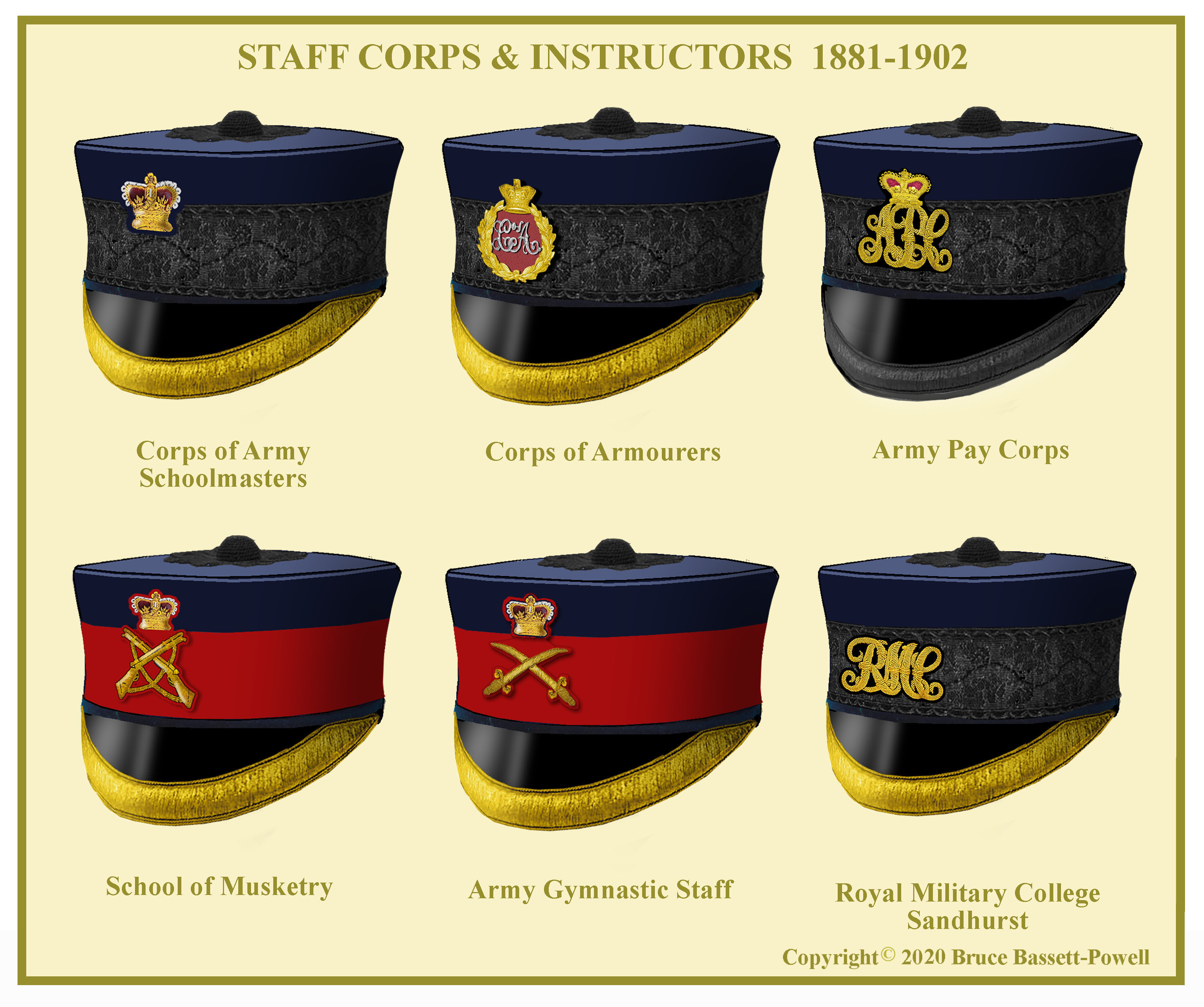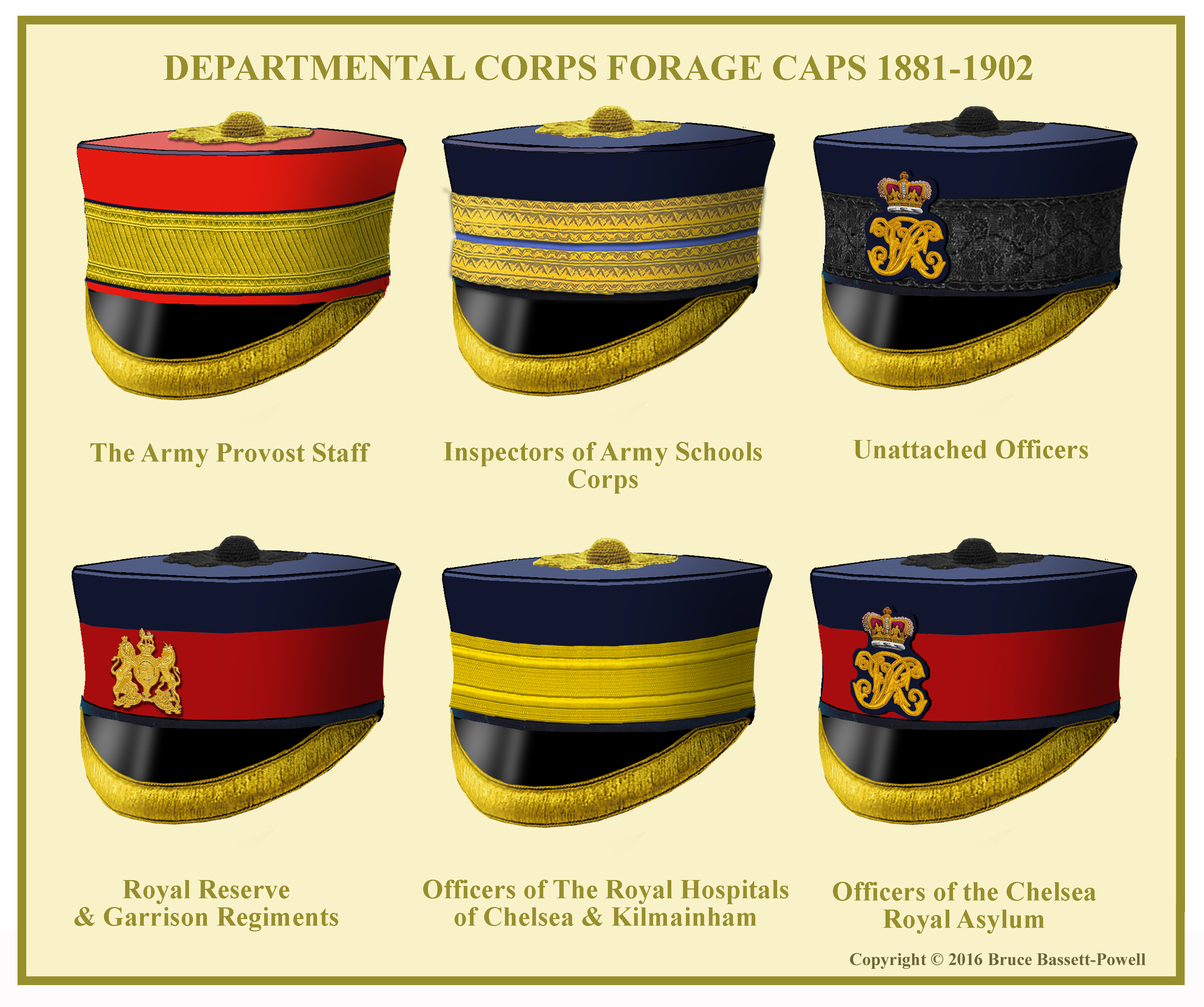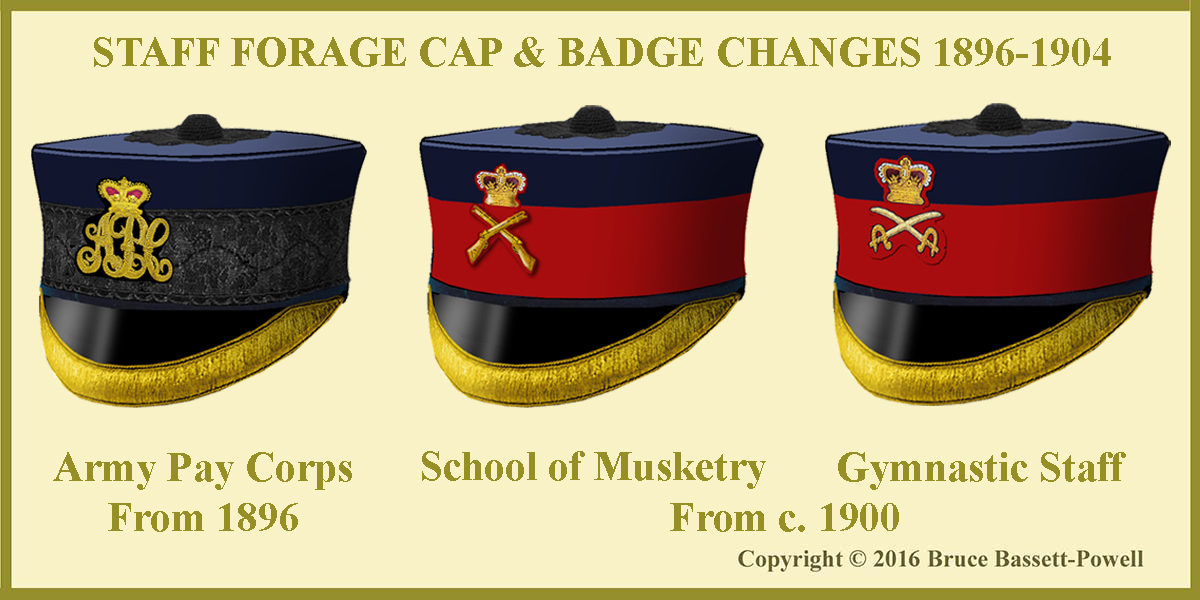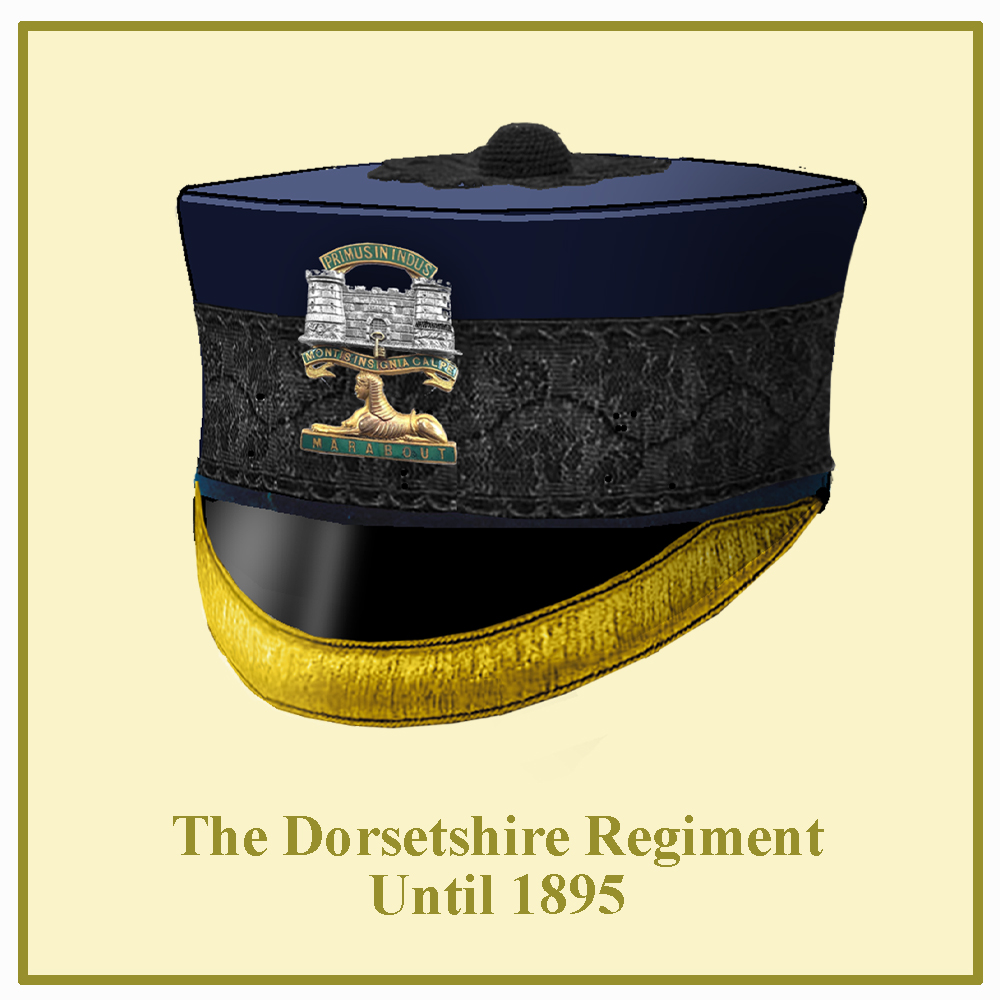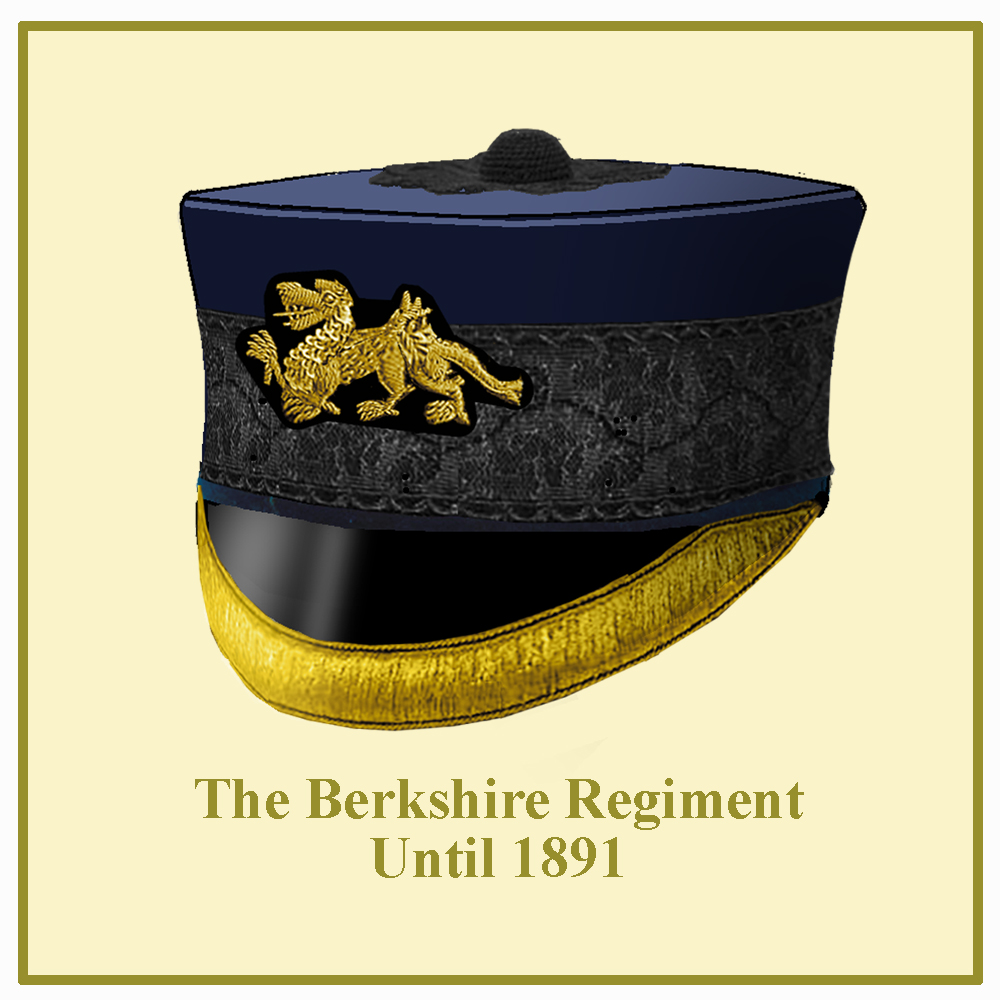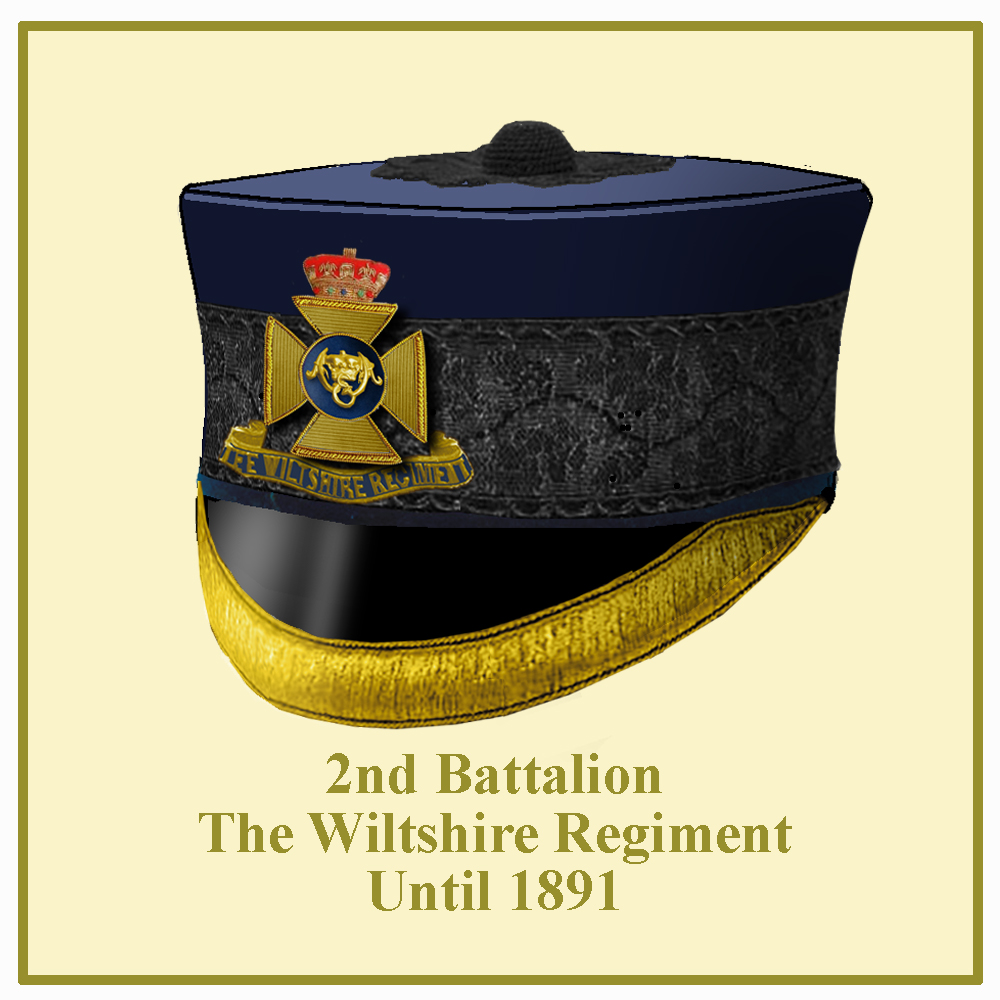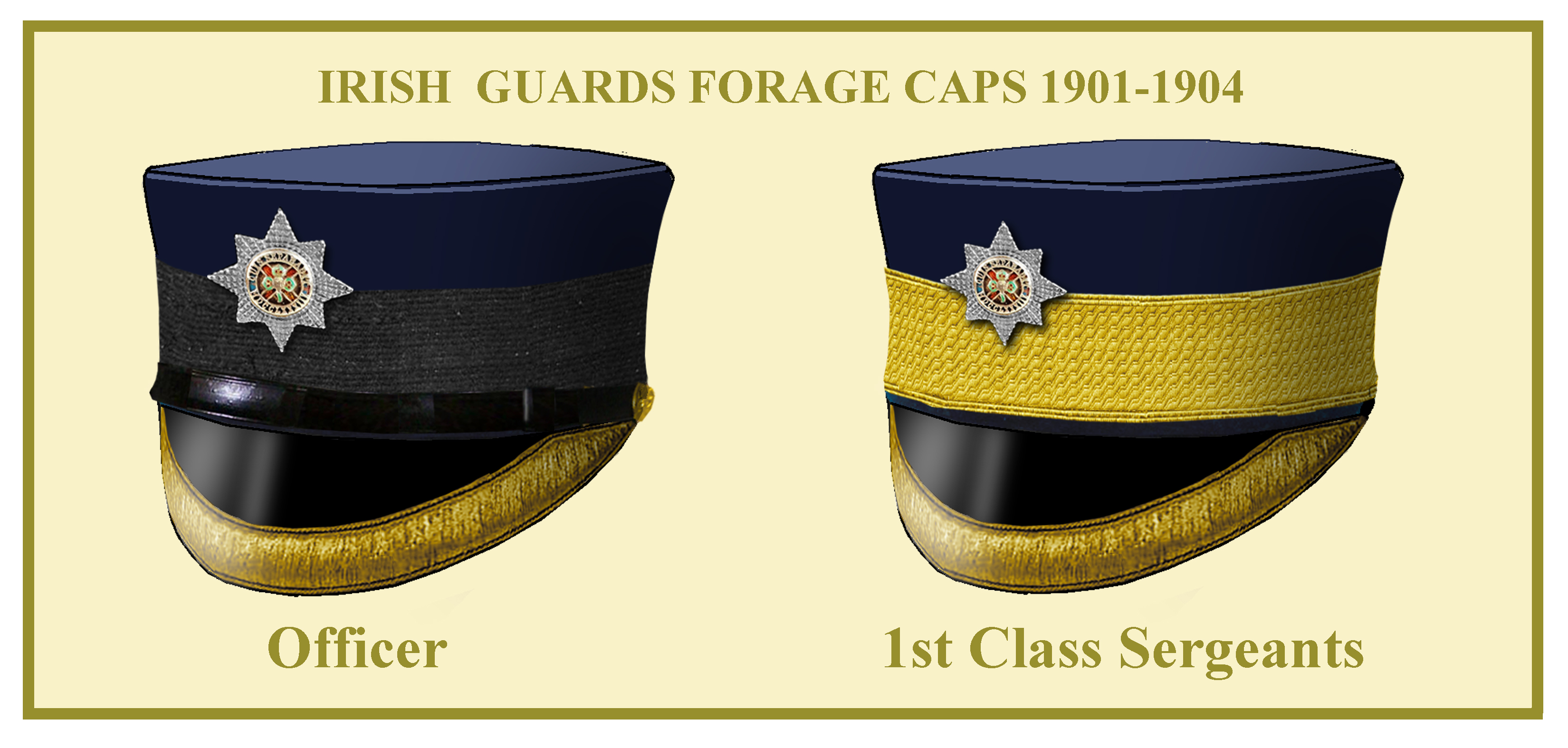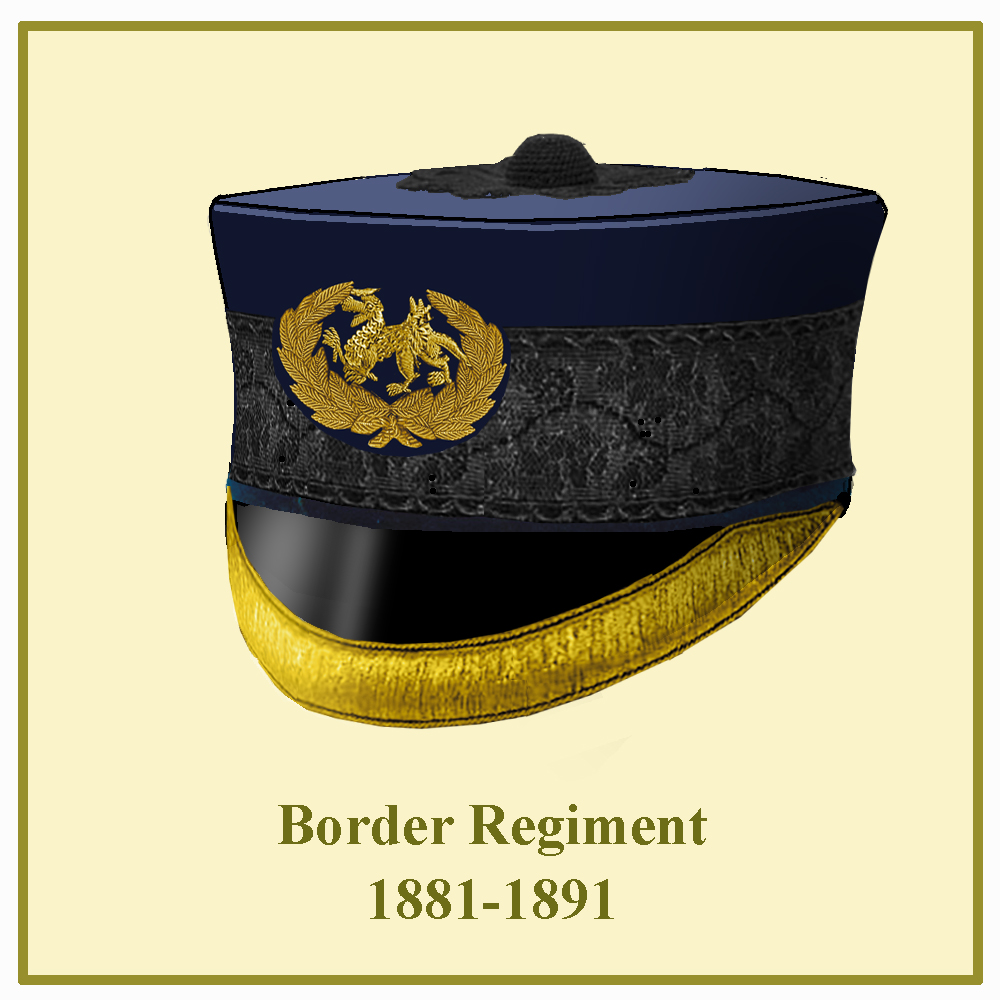PEAKED FORAGE CAPS AND BADGES IN THE BRITISH ARMY 1881-1902
PAGE 3
PART II
FORAGE CAPS WORN BY GENERAL OFFICERS,
CORPS AND ARMY DEPARTMENTS 1881-1902
When the 1880 round forage cap was introduced the use of gold lace bands was greatly expanded. The army staff continued to use the lace that had been introduced some years before but the military departments who had previous worn the black oak leaf band on their caps now had special patterns. By the 1890s, with many of the departments amalgamating and becoming corps, the distinctions were given to other miscellaneous branches of the army like the Military Police and Army School inspectors.
GENERAL OFFICERS & HEADQUARTERS STAFF
The cap, with gold lace oak-leaf pattern had been worn in undress by Field-Marshalls and General Officers since the Crimean War. Colonels and other officers on the Headquarters staff on the staff had worn the same lace until 1864 when a special staff lace was introduced. This appeared in the 1874 regulations and was worn on the round forage cap until 1900. The Indian Staff Corps wore what was essentially two bands of lace separated by a 1/8th inch crimson stripe. The cap was apparently not worn after the Indian Army reorganization of 1897.
ROYAL ARTILLERY, ROYAL ENGINEERS AND DEPARTMENTS
ROYAL ARTILLERY
The round forage cap with peak was worn in the Royal Artillery only by officers on the staff at Woolwich. All other officers, warrant officers and staff sergeants wore the round forage cap without peak. The gold lace band on both caps was of the Royal Artillery pattern.
THE ROYAL ENGINEERS
Prior to 1880, the Royal Engineers had worn its regimental gold lace band on the previous cap with a gold bullion grenade badge on the front. After 1880 the badge was omitted. The RE lace pattern was similar to the staff pattern lace except the pattern slanted from right to left from the top. Although the illustrated Dress Regulations of 1900 showed the lace slanting the same way as the staff pattern, photographic evidence overwhelmingly show otherwise. The cap had a gold netted button on the crown but there was no gold figuring. Field officers had the gold edging to the crown as in the infantry. The cap was worn by all officers, Warrant officers and Staff Sergeants of the Corps.
COMMISSARIAT & TRANSPORT CORPS
The Commissariat and Transport Corps was formed from the ill-fated Control Department in 1875. The band on the C&TC cap was 2 in deep for the Principal Commissary and 1 ¾ in deep for the remaining officers (Shown above). There was a 1/8th dark blue stripe in the centre of the band and a 1/16th inch stripe in the centre of the bullion peak. The cap was not worn by Warrant officers and Staff Sergeants who wore the peak-less pillbox cap.
THE ARMY SERVICE CORPS
The Army Service Corps, created in 1887, was the first department to be converted to full combatant status (although with 4 VCs, they were hardly strangers to combat). The cap shown, worn by the Principal Commissary on the C&TC, was now extended to all officer ranks of the ASC. As with the former corps, WOs and Staff Sergeants did not wear the cap.
THE ORDNANCE DEPARTMENT & ORDNANCE STORE CORPS.
The Ordnance Department had five components of General stores (such as clothing), Warlike Stores, Armourers and the inspectorates of Guns and ordnance. These components became one entity in 1896 but the Department (Officers) and Corps did not combine to become one corps (the RAOC) until 1918. For the Ordnance Department the branch colour was scarlet and the caps of officers followed the same pattern as the C&TC up to 1896. Until that time, Warrant officers and Staff Sergeants had worn the pillbox cap only. After 1896 they wore the round forage cap with a 1 ½ inch band.
THE ARMY PAY DEPARTMENT
The Army Pay Department was formed in 1875 and their caps followed the example of the C&TC and Ordnance with their branch color as bright yellow. After 1896 the thin coloured stripe in the bullion peak was abolished. The Army Pay Corps consisting of NCO staff clerks was formed in 1898 and their cap will be shown in the next plates.
ARMY MEDICAL, CHAPLAINS AND VETERINARY DEPARTMENTS
THE ARMY MEDICAL DEPARTMENT
The Army Medical Department was authorized in 1873 and replaced the regimental medical officers (with the exception of the Household Cavalry and Foot Guards) then serving. Except for Surgeons with equivalent rank to General Officers, the peaked pre 1880 caps had the oak leaf band. After 1880, the gold lace cap band followed the staff pattern with two thin black lines in the 2 inch lace.
THE ARMY HOSPITAL CORPS
Raised in 1857, the Army Hospital Corps provided the stretcher bearers and hospital orderlies under the supervision of the Medical Department. Although consisting of other ranks, it had officers commanding the various bearer companies. The 1880 forage cap bore the oak leaf band with an embroidered Red Cross badge on the front. It was a little larger than that worn on the right sleeves off other ranks. Staff Sergeants continued to wear pill box caps with a brass AHC badge on the front.
THE MEDICAL STAFF CORPS
In 1884, the Army Hospital Corps was replaced by the Medical Staff Corps. The assimilation of this corps within the Army Medical Department was a gradual process. Officers adopted 1 ½ inch Medical department lace on their forage caps In 1896 Staff Sergeants were permitted to wear the round forage cap with the same lace.
THE ROYAL ARMY MEDICAL CORPS
The amalgamation of the all the medical branches took place in 1898 and the R.A.M.C. was formed. For a short time, officers and staff sergeants wore the round forage cap with dull cherry stripes in the lace, but it wasn’t long before the staff forage cap was introduced with the dull cherry band.
THE ARMY CHAPLAINS DEPARTMENT
The forage cap was black with black staff pattern band. The bullion on the peak and the button and decoration on the crown were also black. The embroidered badge of the Maltese cross edged gold was worn in front. According to photographs the badge was often placed wherever the wearer wanted. Before 1893 some chaplains wore a badge of the cross within a gold circle.
THE ARMY VETERINARY DEPARTMENT
Formed in 1878 this department, like the Medical Staff, superceded the veterinary officers on regimental staffs (except the Household cavalry). The Veterinary Department was put on an official footing in 1881. All Veterinary officers wore the round forage cap with the departmental lace and maroon stripe in the centre. By 1892 only the Principal and deputy Veterinary Surgeons wore the peaked cap whilst other officers wore the pillbox cap with the same lace (as befits a cavalry organization).
MISCELLANEOUS UNITS
MILITARY PROVOST STAFF AND MILITARY POLICE
Until 1895, the Provost Marshall wore the round forage cap with staff lace whilst officers of the Military Police and Governors of Military prisons wore the cap with black oak leaf lace. In 1896 the base colour of the cap was changed to scarlet with gold staff lace band and worn by all the officers in the disciplinary corps. The band was edged top and bottom with blue piping as was the edge of the crown.
INSPECTORS OF ARMY SCHOOLS
Before 1890, inspectors of army schools had worn the infantry forage cap with oak leaf lace band and the embroidered Royal Cypher badge. In 1891, the band on the cap was changed to departmental pattern with light blue stripe in the middle.
UNATTACHED OFFICERS
Officers that were not attached to any corps or department wore the Infantry (non-Royal) cap with embroidered Royal Cypher badge. This badge was also worn by 1st Class NCOs in Garrison Staff appointments.
ROYAL RESERVE AND GARRISON REGIMENTS
In 1900, largely because of the large commitments of manpower involved in the South African War, several Royal Reserve regiments, recruited from veterans, were raised for home defence. After a year they stood down, but were replaced by five Garrison regiments, with terms of service to include overseas service. The officers and staff sergeants of these regiments, less those raised in Scotland, wore the Infantry forage cap with scarlet band and a brass, Royal Arms badge. From 1902 the caps were phased out.
OFFICERS OF THE ROYAL HOSPITALS OF CHELSEA AND KILMAINHAM
Officers of these institutions wore the round forage cap with special lace band of “Double Vellum” pattern.
OFFICERS OF THE ROYAL ASYLUM AT CHELSEA
The caps for these officers were of the pattern worn by Royal regiments of infantry with the embroidered Royal Cypher badge.
In the latter half of the 19th century a number of small and highly specialised departmental staff corps came into being to meet the increasing demands of technology, education, physical fitness, and pay and allowances. The staff corps were responsible for a range of army administrative matters and in accordance with the social strata of the time often had an entirely separate, but associated officer corps.
-------------------------------------------------------------
THE CORPS OF ARMY SCHOOLMASTERS
Founded as early as 1846, this body of NCOs, later to be ranked as staff sergeants were, after 1870 attached to every battalion, regiment and corps of the army. From the beginning, the badge worn on their forage caps was the gold bullion crown. The most senior possible in a unit was warrant officer and for a period they were some of the earliest warrant officers to ever be appointed in the regular army. They did not use conventional rank badges, but did wear the round forage cap and bullion shoulder cords in an elaborate knot.
THE CORPS OF ARMOURER SERGEANTS
Formed in 1858, this corps was responsible for the maintenance and repair of all infantry small arms, but not artillery, which was the responsibility of the Corps of Ordnance Artificers, nor initially cavalry, where directly engaged armourers continued to be employed for several more decades. The Corps of Armourers was always associated with the Ordnance Department, having its depot first at Enfield Lock and later at Birmingham, Sparkbrook. Among the first sergeants to be appointed to the headquarters staff of each infantry battalion, the armourers always wore the dress and insignia of the regiment to which they were attached, and this included the round forage cap and red sash. However, for administrative purposes the corps was wholly absorbed by the Ordnance Store Corps (OSC) on 1 April 1895, as the Armourer Section, and photographic evidence suggests that it was at that point that discrete, but short-lived Corps of Armourers' forage cap and helmet badges were adopted, along with the uniform of the OSC. Exactly one year to the day later, on 1 April 1896, the OSC was reorganised as the Army Ordnance Corps (AOC) and it was decided that all elements of the AOC would adopt the same dress and a generic insignia. During its very brief existence the special badge of the Corps of Armourers was usually worn with a crimson backing.
THE ARMY PAY CORPS
The NCO and soldier Pay specialists of the Corps of Military Staff Clerks were detached and absorbed into a separate Army Pay Corps (APC) in 1893. Clothing regulations stipulated the round forage cap and letters APC, surmounted by the crown in 1894. The badge worn was in gold bullion and initially, clear photographic evidence shows that the cap's peak was laced with black silk edging, a variation originally intended for staff sergeants in military hatters adverts as early as 1881. Later photos show that the peaks had changed to gold bullion edging after 1896, thus bringing them in line with the type used by the rest of the army. (See Below). The APC was amalgamated with the officers of the Army Pay Department in 1920, when it became the Royal Army Pay Corps.
SCHOOLS OF INSTRUCTION
The two principal “Schools of Instruction” corps were both formed in the immediate aftermath of the Crimean War and intended to indoctrinate the infantry especially, but also other arms, with changes to linear tactics that demanded a much greater individual skill from each and every soldier. They almost entirely consisted of warrant officers, staff sergeants and experienced NCOs commanded by senior commissioned officers, often from the combat arms. From the outset, both corps were dressed specifically in the style of infantry sergeants of staff grade, with scarlet tunics, red infantry sashes and even the scarlet forage cap bands more usually reserved for units with a Royal appellation. This was very probably because training was an adjunct of the Adjutant General's Department.
THE SCHOOL OF MUSKETRY
In 1853 this school was established at Hythe, in Kent. From the beginning, they wore the bullion badge of crossed rifle muskets above their chevrons and on forage caps with peaks. At first the badge was crossed rifle muskets with slings and crown above, but from 1900, the badge became crossed magazine fed rifles, also surmounted by a crown, but without slings until the gradual introduction of the staff pattern cap from 1905 onward. (See Below)
THE ARMY GYMNASTIC STAFF
This corps was formed in 1860 and the first military gymnasium was established in Wellington lines, Aldershot in 1861, at which point they were officially titled the “Army Gymnastic Staff” (AGS) and recognized as a school of instruction. As with the School of Musketry, the AGS wore a bullion badge, but with crossed scimitars and crown above, on both scarlet tunic and forage cap. From around 1900 this changed to swords with a covered hilt, but was otherwise similar, although the day-to-day working dress was that of the gymnasium and round forage caps were only worn for more formal duties and parades. (See Below)
THE ROYAL MILITARY COLLEGE
The badge of “RMC” in metal had been worn by instructional staff at Sandhurst since the mid-1880s. A bullion version was adopted in 1896 and worn by senior cadets on round forage caps.
ADDITIONAL CAPS & BADGES WORN
CONCLUSION AND POST 1902
FORAGE CAP DEVELOPMENTS
THE IRISH GUARDS
The Irish Guards were formed by Queen Victoria on April 1st, 1900 to honour the Irishmen who had fought in the Second Boer War. Their full dress was the same pattern as the other three regiments of foot guards except with insignia, button spacing (in fours) cuffs and skirt decorations of regimental pattern. In undress, the regiment was issued with the Brodrick Cap (see on Page 4). However, officers, staff sergeants and bandsmen of all ranks were issued with the same pattern as the other regiments. It was worn until 1904 when the new, guards pattern forage cap with brass bound peak was introduced.


